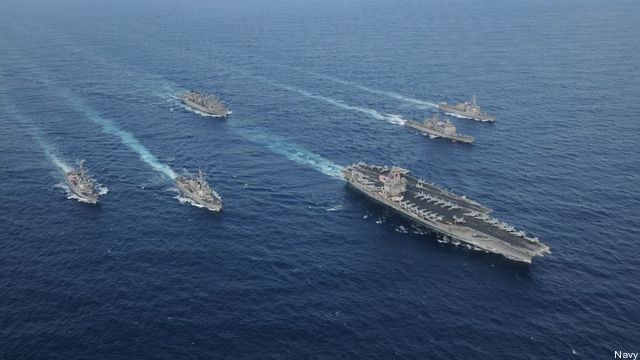Cutting Navy While Obama Pivots To Asia Does Not Add Up
Posted on

You know it’s bad when the President’s own national security adviser calls the Secretary of Defense over for a meeting at the White House to explain exactly how the administration is “pivoting” to Asia yet shrinking the Navy and the Air Force. But that’s what happened earlier this year. It is no surprise given the administration’s budget-strategy mismatch.
When President Obama unveiled his new strategic guidance in January, highlighted by a pivot to Asia, many assumed (incorrectly) that the Navy and Air Force would reap the benefits. But if the president’s own 2013 defense budget request did not make it clear to policymakers already, the release of the Navy’s 30-year shipbuilding plan confirms this is a pivot in name only.
The Navy would have fared better merely holding steady at last year’s resource levels before the pivot and budget cuts shrank the sea service. Five months later, the administration’s new plan stops paying even lip service to a 313-ship Navy, the same 313-ship plan that was considered the minimum needed by the last Chief of Naval Operations.
The Navy spends the vast majority of its time assuring and deterring others, not fighting battles. Networks do not deter potential aggressors nor support and assure our friends and allies. Ships steaming the world’s oceans and sailors home ported in foreign docks do that. Quantity is still important and even more so when the pivot is to a region defined by vast distances. But at no point over the next three decades will the U.S. Navy approach a fleet size totaling 313 ships. Under the new proposal, the fleet falls under 300 ships for nearly half of the 30 year span. The new fleet average is roughly 298 ships.
But even a fleet of 298 ships is optimistic given that the Navy’s latest plan overinflates force levels due to excessive ship life estimates. The new plan assumes 40-year hull lives for DDGs and 35 years for cruisers. This means the gap in major surface combatants is now underrepresented in the revised proposal.
One of the Navy’s most competitive advantages is its attack submarine fleet and capabilities. Yet the new shipbuilding plan drops the number of SSNs to 43 from 48 at the same time the service plans to build just one per year in 2026.
The shortcomings of the Navy’s 2013 shipbuilding plan are especially transparent when compared to their updated plan of just a short half-year ago. In the Navy’s September plan, it would have exceeded its target for 313 ships in 9 out of 30 yrs, or 30% of the time. Conversely, it would have fallen below a 300 ship floor for 11 of the 30 years, just over one-third of the time. Over the course of last year’s long-term plan, the fleet would have averaged 306 ships in any given year.
Perhaps the most troubling part of the new shipbuilding plan and the 2013 budget is that they simply build fewer ships. As little as five months ago, the administration said the Navy needed to construct 276 ships. Today: 268. While the difference seems slight, what it means is that with fewer new ships, the Navy will be forced to put increased stress and strain upon the rest of the fleet as older ships are kept in service past their intended retirement dates. Ships are already sitting out missions because of decreasing readiness, and with an increased emphasis on the Pacific combined with an older fleet, still more ships will be unable to meet their responsibilities at sea.
The Navy faces a stark risk in the short term. Last year’s Navy budget funded the construction of 57 ships from FY 2013 through FY 2017. The pivot budget cuts this to 41 ships, leaving the Navy with fewer than 280 ships in FY 2014 and FY 2015. Despite technological advances in battle networks, numbers still matter. Ships, no matter how capable, cannot be in two places at once. When it comes to maritime patrols, fewer ships at sea means the visible and stabilizing presence of American warships will rotate through foreign ports less often, undermining deterrence, and failing to resource America’s commitment to its many allies.
Nonetheless, the Navy is prioritizing the fleet’s most important warfighting ships: submarines, large surface combatants and aircraft carriers. The new 30-year plan averages more nuclear attack submarines in the fleet each year, builds nearly 20 more large surface combatants than the last plan, and keeps last year’s goal of six new aircraft carriers over the next three decades.
The Navy didn’t decide to make do with fewer resources. It was handed a budget number and forced to meet that diminished target.
The latest budget and associated plans that are supposedly emphasizing the Asia-Pacific are part of a hollow shell game. The bottom line is that this Administration’s defense strategy proposes one thing while its own defense budget does the opposite. It’s no wonder the President’s national security adviser had trouble rationalizing the latest defense budget because it just doesn’t add up.
Mackenzie Eaglen, a former congressional staffer and member of the Breaking Defense Board of Contributors, is a defense analyst at the conservative American Enterprise Institute.
Subscribe to our newsletter
Promotions, new products and sales. Directly to your inbox.
